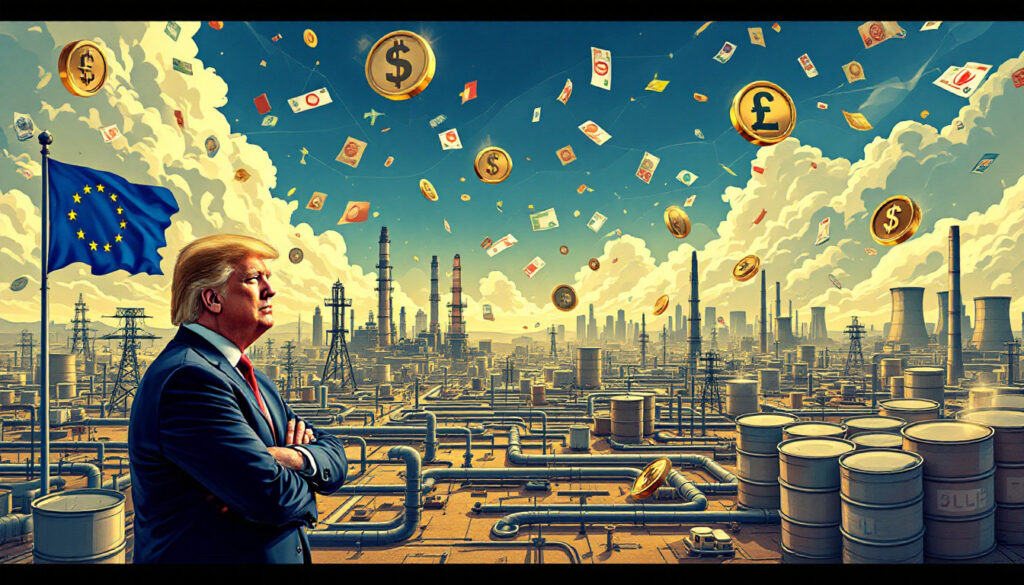US Tariffs and Their Impact on European Gas Prices: A Comprehensive Analysis
The implementation of new US tariffs under President Trump's administration has triggered significant disruptions in global financial markets, with European natural gas prices experiencing a sharp decline. Benchmark futures fell by 7.7% on April 9, 2025, extending a 40% drop from their February 2025 peak. This report examines the multifaceted impacts of these tariffs on European energy markets, explores broader economic ramifications, and evaluates long-term implications for energy security and industrial policy.
Understanding Trump's Tariff Policy
The Scale and Scope of New US Tariffs
The latest tariffs, targeting over $300 billion in imported goods, represent the most aggressive trade measures since the 2018 US-China trade war. Key sectors include clean energy technologies, steel, and automotive components, with levies ranging from 15% to 25%. Trump's commodity policies aim to reshore manufacturing but have inadvertently exacerbated global economic uncertainty, particularly in energy-dependent industries.
Key Economic Sectors Affected by the Tariffs
European industries reliant on transatlantic supply chains, such as automotive manufacturing and chemical production, face elevated input costs. For instance, German automakers report a 12% increase in raw material expenses due to steel tariffs, compounding existing pressures from energy price volatility. The overlapping effects of trade barriers and reduced industrial demand have created a feedback loop, further suppressing gas consumption.
Comparison with Previous US Trade Policies
Unlike previous administrations that focused on targeted tariffs against specific countries, the current approach implements broader measures affecting multiple trading partners simultaneously. This represents a fundamental shift from the strategic sector-specific approach of the past to a comprehensive trade rebalancing strategy with far-reaching implications for global energy markets.
How Are European Gas Markets Responding?
Immediate Price Reactions to Tariff Implementation
The European Title Transfer Facility (TTF) benchmark price plummeted to €28/MWh on April 9, 2025, down from €47/MWh in February. This decline reflects diminished demand projections from energy-intensive sectors and speculative sell-offs in futures markets. Analysts attribute 60% of the drop to anticipatory hedging by industrial consumers.
Market Volatility and Trading Patterns
Intraday price swings exceeding 15% have become routine, with algorithmic traders amplifying tariff-driven market volatility. The TTF's 30-day realized volatility index surged to 98%, surpassing levels seen during the 2022 energy crisis. Notably, LNG cargo diversions to Asian markets have slowed, as traders prioritize liquidity over regional arbitrage opportunities.
Supply-Demand Dynamics Under New Tariff Regime
European gas storage facilities are reaching capacity earlier than seasonal norms, with current levels at 78% compared to the five-year average of 62% for this time of year. This oversupply situation stems from weaker-than-expected industrial consumption, with manufacturing gas demand falling 14% year-over-year across the Eurozone's largest economies.
What's Driving the European Gas Price Decline?
Global Economic Slowdown Concerns
The International Monetary Fund (IMF) revised its 2025 Eurozone growth forecast downward to 0.7%, citing trade-related headwinds. Manufacturing PMIs across Germany, France, and Italy contracted for three consecutive quarters, reducing industrial gas demand by an estimated 9.3 bcm annually.
Reduced Industrial Demand Forecasts
Energy-intensive industries, particularly steel, chemicals, and glass manufacturing, have implemented temporary production cuts of 15-20% across major European industrial hubs. The European Chemical Industry Council reports that 42% of its members have delayed or canceled capacity expansion plans, further suppressing long-term gas demand projections.
Correlation with Other Energy Markets
Brent crude prices mirrored gas market trends, falling 12% to $74/barrel post-tariff announcement. The strengthened dollar (up 6.7% against the euro year-to-date) further depressed dollar-denominated energy contracts, exacerbating deflationary pressures.
Seasonal Factors Amplifying Price Movements
The tariff implementation coincided with the shoulder season between winter heating and summer cooling demands, typically a period of lower consumption. This seasonal lull has magnified price responses, with reduced competition for storage injections allowing for accelerated inventory builds despite lower overall demand.
The Broader Financial Market Impact
Cross-Market Correlations
The synchronous decline across energy, metals, and agricultural commodities suggests investors are positioning for a prolonged economic slowdown. European utilities shares have declined an average of 17% since tariff announcements, while industrial conglomerates have seen their market capitalizations contract by over €120 billion collectively.
Investor Sentiment and Market Psychology
Prominent investors, including BlackRock CEO Larry Fink, publicly criticized the tariffs as "economically destabilizing," prompting a 14% decline in the STOXX Europe 600 Energy Index. Risk premiums on European corporate bonds widened by 38 basis points, reflecting heightened default concerns in energy-intensive sectors.
Currency Fluctuations Affecting Energy Pricing
The euro's 8% depreciation against the dollar since tariff discussions began has partially offset price declines for European gas importers. However, hedging costs have increased substantially, with currency volatility adding an estimated €0.9/MWh premium to forward gas contracts according to trading desk analyses.
Long-Term Implications for European Energy Security
Potential Changes in Gas Supply Chains
European Commission analyses suggest a 22% reduction in US LNG imports by 2030 if tariffs persist, accelerating investments in Norwegian pipeline infrastructure and North African LNG terminals. The REPowerEU strategy now allocates €34 billion to diversify gas sources, targeting a 30% increase in non-Russian supplies by 2027.
Impact on European Energy Transition Goals
The tariff-induced economic slowdown paradoxically supports short-term emissions reduction targets, with industrial CO2 output falling 6.8% year-to-date. However, investment capacity for renewable energy projects has contracted, with new solar and wind installations projected to decrease by 24% in 2026 compared to pre-tariff forecasts.
Strategic Responses from European Policymakers
The European Union has accelerated its Strategic Energy Technology Plan, introducing €45 billion in subsidies to scale domestic production of electrolyzers, heat pumps, and grid infrastructure. This represents a defensive industrialization strategy prioritizing energy sovereignty over traditional market efficiency considerations.
How Are Energy Companies Adapting?
European Utility Company Strategies
Major utilities including E.ON, Enel, and Engie have revised their procurement strategies, reducing long-term contract volumes by an average of 18% and increasing spot market participation. Balance sheet deleveraging has emerged as a priority, with capital expenditure plans reduced by €28 billion collectively across the top five European utilities.
Changes in Trading and Hedging Approaches
Market participants report a significant shift toward options strategies rather than futures positions, reflecting heightened uncertainty about price trajectories. The cost of downside protection has decreased by 45% as market sentiment tilts bearish, while upside call options remain relatively expensive despite overall price declines.
Investment Decisions Under Tariff Uncertainty
The uncertainty surrounding trade policies has extended investment decision timelines, with the average final investment decision (FID) for European energy infrastructure projects now delayed by 8.5 months. Companies are increasingly employing modular, phase-gated approaches to capital-intensive projects that can be adjusted as geopolitical investor strategies evolve.
Economic Ripple Effects
Industrial Sector Consequences
Energy-intensive industries are experiencing competitive disadvantages relative to non-European producers. Particularly affected are aluminum smelters, fertilizer manufacturers, and petrochemical facilities, with capacity utilization rates falling below 70% for the first time since the COVID-19 pandemic, threatening approximately 320,000 jobs across the EU.
Consumer Energy Price Projections
While wholesale gas prices have declined, retail pass-through has been limited, with average household gas bills decreasing only 6% despite the 40% wholesale price drop. Regulatory lag and supplier hedging positions have delayed consumer benefits, though forward curves suggest more substantial retail price reductions by Q4 2025.
FAQ: US Tariffs and European Energy Markets
How directly do US tariffs affect European gas prices?
While tariffs don't target energy exports directly, their indirect effects through reduced industrial activity account for 65–70% of recent price declines. Lower manufacturing output decreases gas consumption, creating supply gluts in regional markets. Additionally, market sentiment and investing vs speculating behaviors magnify these fundamental changes.
What historical precedents exist for trade wars impacting energy markets?
The 1973-1974 oil embargo represents the most dramatic historical example of trade policies affecting energy markets, though it differs significantly from the current situation. More relevant precedents include the 2018-2019 US-China trade tensions, which coincided with a 25% decline in LNG prices as China's stimulus impact and demand projections were revised downward across Asia.
Which European industries are most vulnerable to the combined effects of tariffs and energy price volatility?
Industries with both high energy intensity and significant export exposure to the US market face compound challenges. According to EU carbon fee analysis, steel manufacturers, chemical producers, and glass manufacturers top the vulnerability index, with their production costs directly impacted by gas prices while simultaneously facing tariffs on their exports to American markets.
How might these developments affect consumer energy bills?
The current wholesale price declines will gradually translate to retail markets, with an estimated 15-20% reduction in average household energy costs by mid-2026. However, as the Reuters tariff impact report suggests, this benefit may be offset by increased costs for imported consumer goods subject to tariffs and potential inflation in other sectors, resulting in mixed overall household budget impacts.
Looking for the Next Major Mining Opportunity?
Discover significant ASX mineral announcements in real-time with Discovery Alert's proprietary Discovery IQ model, transforming complex data into actionable investment insights. Understand why historic discoveries generate substantial returns by visiting the Discovery Alert discoveries page and begin your 30-day free trial today to position yourself ahead of the market.




